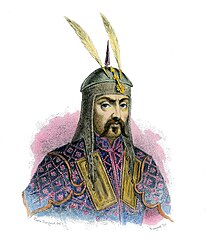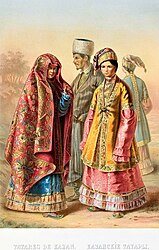The Tatars are a Turkic ethnic group primarily inhabiting the region of Tatarstan in Russia, as well as other parts of Russia and neighboring countries.
Tatars reside in the Republic of Tatarstan (2 million people), Bashkortostan (991,000 people), Udmurtia, Mordovia, the Mari El Republic, Chuvashia, as well as in the Volga-Ural region, Western and Eastern Siberia, and the Far East. They also live in Kazakhstan, Uzbekistan, Tajikistan, Kyrgyzstan, Turkmenistan, Azerbaijan, Ukraine, Lithuania, Latvia, and Estonia.
According to the 2010 census, on the whole, there were 5,310,649 Tatars living in Russia.[1]
The Tatar-Mongols

The conquerors who came to Rus were not exactly Tatars. The true Tatars roamed southeast of Lake Baikal along the northern border of China, guarding the approaches to the Great Wall of China from the raids of nomadic tribes, including the Mongols.
The Tatars were never allies of the Mongols and never participated in their conquest campaigns; on the contrary, they were constantly at odds with them. In the second half of the 12th century, Genghis Khan's father, Yesugei, inflicted a major defeat on the Tatars, for which they poisoned him a few years later. When Genghis Khan came to power in Mongolia, he brutally avenged his father's death, orchestrating a bloody massacre. The results of this massacre are known from the "Secret History of the Mongols"[2]: the Mongols slaughtered anyone who was taller than the axle of a cart.
As a result, in the early 13th century, the Tatars virtually ceased to exist not only as a military force but also as an ethnic group. However, their name continued to be used in Chinese historical writings of that time in reference to the Mongols.
The subjects of Genghis Khan themselves referred to themselves as Mongols, and their state as the Mongol Empire. The fusion of these two ethnonyms into the concept of "Mongol-Tatars" or "Tatar-Mongols" was observed in medieval Chinese historiography and official texts, starting from the era of the Song dynasty (960-1279), when the tradition gradually emerged to refer to the Mongols ("Manchu") and all other Mongolic-speaking tribes as Tatars ("Dada") or Mongol-Tatars ("Menda").[3]
Ethnonym
The word "Tatars" in medieval Chinese historiography corresponded to the European concept of "barbarians." Just as the Greeks and Romans viewed the proud barbarians (from the ancient Greek βάρβαρος meaning "non-Greek, foreign") as uncivilized, the Tatars appeared as complete savages in the eyes of enlightened Chinese. Moreover, they spoke in an incomprehensible dialect, and their words sounded like complete gibberish to educated ears - "bar-bar" (Latin barbarus, which came into Russian as "barbarians") or "tar-tar."[1] Without much effort in ethnographic research, the Chinese extended the ethnonym "Tatars" to other tribes living north of the actual Tatars, including the Mongols. It was through Chinese influence that the ethnonym "Tatars" was brought to Europe long before the arrival of the troops led by Khan Batu, as he was called by his compatriots. Thus, it is thanks to the Chinese that we still use the ethnonym "Tatars."
History of Tatar statehood
After the dissolution of the Golden Horde, new Turkic-Tatar states emerged on its territory, continuing its traditions: the Kazan Khanate, the Tyumen (Siberian) Khanate, the Crimean Khanate, the Astrakhan Khanate, the Kasimov Khanate, the Great Horde, the Nogai Horde, and others.
During the 16th-18th centuries, all Tatar khanates were conquered by the Russian state, but the old state traditions served as one of the important stimuli for preserving the unity of the people.
At the beginning of the 20th century, the Tatars intensified their struggle for the restoration of their statehood, initially in the form of national-cultural autonomy. In 1918, the Millat Majlis made a decision to create the Ural-Volga State. The attempt to establish it on March 1, 1918 (see "Siberian Republic") was suppressed by the Soviet government. In 1918, the People's Commissariat for Nationalities Affairs of the RSFSR announced the position of the Tatar-Bashkir Soviet Socialist Republic (which remained unrealized).
In 1920, the Tatar ASSR was formed as part of the RSFSR. By the declaration of the Supreme Council of the Republic on August 30, 1990, the Tatar ASSR was transformed into the Republic of Tatarstan. The Republic of Tatarstan is now a subject of the Russian Federation, it is part of the Volga Federal District and is a part of the Volga Economic Region..[4]
Tatar language
The Tatar language belongs to the Kipchak-Bulgar subgroup of the Kipchak group within the Turkic branch of the Altaic language family. It has three main dialects: Western (Mishar), Middle (Kazan-Tatar), and Eastern (Siberian Tatar). The literary norm is based on the Kazan-Tatar dialect with the participation of the Mishar dialect. The writing system is based on the Cyrillic script.
Tatar religion
The majority of Tatars are Sunni Muslims of the Hanafi school. The population of the former Volga Bulgaria embraced Islam from the 10th century and remained Muslim during the time of the Horde, which distinguished them from neighboring peoples. Later, after the Tatars became part of the Moscow state, their ethnic identity became even more intertwined with their religious identity. Some Tatars even identified their national belonging as "Messelman," i.e., Muslims. At the same time, they retained (and to some extent still retain) elements of pre-Islamic calendar rituals.[5]
Tatar costume

The traditional Tatar costume for men and women consisted of wide-legged trousers called "sharawar" and a shirt, onto which a sleeveless vest, often embroidered, was worn. The women's Tatar costume was distinguished by an abundance of silver ornaments, cowrie shells, and glass beads. The outerwear included a "kazakin" for men and a quilted "beshmet" or fur coat for winter. Men wore a "tyubeteyka" on their heads, and on top of it, a fur hat or a felt hat. Women wore an embroidered velvet cap and a scarf. Traditional Tatar footwear included leather "ichigi" with soft soles, worn with overshoes.
See also
Explore more about the Tatars
- Most common ethnicities in Russia on MyHeritage
- Russian historical records on MyHeritage
- The Tatars on Encyclopedia Britannica
- Peter J.Potichnjy. The struggle of the Crimean Tatars on JStore
References
- ↑ https://nazaccent.ru/nations/tatar/
- ↑ "Secret History of the Mongols" is the oldest surviving literary work in the Mongolian language.
- ↑ https://arzamas.academy/mag/905-igo
- ↑ https://tatarica.org/ru/razdely/narody/tatary/tatary
- ↑ https://nazaccent.ru/nations/tatar/